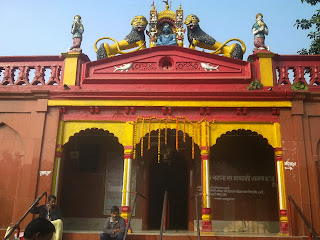First President of the Republic of India shri Dr. Rajendra Prasad
First President of the Republic of India (shri. Dr. Rajendra Prasad)
Dr. Rajendra Prasad was a Kayastha and born in Zeradei, in the Siwan District of Bihar near Chhapra on December 3, 1884. His father Mahadev Sahai was a scholar of both the Persian and Sanskrit languages, while his mother, Kamleshwari Devi, was a religious woman who would tell stories from the Ramayana to her son. He was the youngest son in the family.When Prasad was 5 years old, his parents placed him under the tutelage of a Moulavi, an accomplished Muslim scholar, to learn the Persian language, Hindi and arithmetic.
After the completion of traditional elementary education, he was sent to the Chapra District School and at a small age of 12, he was married to Rajavanshi Devi. He, along with his elder brother Mahendra Prasad, then went to study at T.K. Ghosh's Academy in Patna for a period of two years. He was a brilliant student; stood first in the entrance examination to the University of Calcutta, he was awarded a Rs.30/month scholarship. He joined the famed Calcutta Presidency College in 1902, initially as a science student He passed Intermediate level classes then called as F. A. under the University of Calcutta in March 1904. He was a great scholar. It can be proved from the comment of an examiner who wrote on his answer sheet "examinee is better than examiner". Later he decided to focus on the arts and did his M.A. in Economics with first division from the University of Calcutta in December 1907. There he lived with his brother in the Eden Hindu Hostel. In 1915, Rajendra passed the master's in law examination with honours, winning a gold medal. Subsequently, he completed his Doctorate in Law as well.
In the year 1916, he joined the High Court of Bihar and Odisha. Later in the year 1917, he was appointed as one of the first members of the Senate and Syndicate of the Patna University. He also used to practice law at Bhagalpur, the famous silk-town of Bihar.
Dr. Prasad always drew his helping hand towards needy people. He was present to help reduce the pain. In 1914 floods ravaged Bihar and Bengal. Dr. Prasad became a volunteer distributing food and cloth to the flood victims. In 1934, Bihar was shaken by an earthquake, which caused immense damage and loss of property. The quake, devastating by itself, was followed by floods and an outbreak of malaria which heightened misery. Dr. Prasad dove right in with relief work, collecting food, clothes and medicine. His experiences here led to similar efforts elsewhere too. In 1935, an earthquake hit Quetta. Dr. Prasad was not allowed to lend a hand because of Government restrictions. Nevertheless, he set up relief committees in Sind and Punjab for the homeless victims who flocked there.
An Indian political leader, lawyer by training, Prasad joined the Indian National Congress during the Indian independence movement and became a major leader from the region of Bihar. A supporter of Mahatma Gandhi, Prasad was imprisoned by British authorities during the Salt Satyagraha of 1931 and the Quit India movement of 1942. Prasad served one term as President of the Indian National Congress from 1934 to 1935. After the 1946 elections, Prasad served as minister of food and agriculture in the central government. Upon independence in 1947, Prasad was elected president of the Constituent Assembly of India, which prepared the Constitution of India and served as its provisional parliament.
When India became a Republic on January 26, 1950, Prasad was elected its first President by the Constituent Assembly. Following the general election of 1951, he was elected President by the electoral college of the first Parliament of India and its state legislatures. As President, Prasad established a tradition of non-partisanship and independence for the office-bearer and retired from Congress party politics. Although a ceremonial head of state, Prasad encouraged the development of education in India and advised the Nehru government on several occasions. In 1957, Prasad was re-elected to the presidency, becoming the only president to have been twice the office. He stressed the need for peace in a nuclear age.
In 1962, after 12 years as President, Dr. Prasad retired, and was subsequently awarded the Bharat Ratna, the nation's highest civilian award. With the many tumults of his vigorous and accomplished life, Dr. Prasad recorded his life and the decades before independence in many books.
He died on 28 February 1963 with 'Ram Ram' on his lips. Sadakat Ashram memorial in Patna is dedicated to him.








Comments
Post a Comment